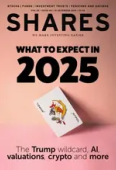Archived article
Please note that tax, investment, pension and ISA rules can change and the information and any views contained in this article may now be inaccurate.
China eases monetary policy ahead of Trump 2.0 and global tariff war

It may not seem much to non-China watchers, but the Communist party’s politburo has changed the wording of its stance on monetary policy for the first time since the 2007/8 financial crisis from ‘prudent’ to ‘moderately loose’.
Chinese and Hong Kong listed shares jumped, as did those of UK and European stocks which have large exposure to the region including miners Antofagasta (ANTO) and Rio Tinto (RIO), insurer Prudential (PRU) and luxury firms Burberry (BRBY) and LVMH (MC:EPA).
The top leadership of the party is set to meet to lay out the economic agenda for 2025, and in a statement the government said it would implement more proactive fiscal policies and looser monetary policy to ‘vigorously boost consumption, improve investment efficiency and expand domestic demand in all directions’.
There was also a pledge to ‘stabilise’ property and stock markets and a reference to the use of ‘extraordinary’ policy adjustments if necessary to boost the economy, all of which suggests the Chinese leadership is taking the threat of a trade war seriously.
In an interview with Bloomberg, ANZ Banking Group’s senior strategist Zhaopeng Xing described the wording in the government’s statement as ‘unprecedented’, while Exante Data senior strategist Martin Rasmussen said it showed the party leaders’ view on economic conditions ‘has shifted substantially’ in the last couple of months.
On top of the threat of a trade war, China’s economy has been struggling with falling prices, as shown by November’s PPI (producer price index), which measures the price of goods sold by manufacturers and which fell for the 26th month in a row, eating into corporate profits and undermining the government’s efforts to grow the economy at a 5% rate.
At the same time, consumer prices hit a five-month low in November with inflation rising just 0.2% year-on-year compared with economists’ forecasts of a 0.5% increase according to a Reuters poll.
‘The Chinese economy continues to flirt with deflation, highlighting the inadequacy of the stimulus measures thus far in restoring private sector confidence, reviving domestic demand and putting growth back on track,’ commented Eswar Prasad, professor at Cornell University, in an interview with the Financial Times.
The last time China adopted a ‘moderately loose’ monetary stance was between 2008 and 2010 when it tried to prop up the economy with massive amounts of government spending, a move it had vowed it wouldn’t repeat.
Important information:
These articles are provided by Shares magazine which is published by AJ Bell Media, a part of AJ Bell. Shares is not written by AJ Bell.
Shares is provided for your general information and use and is not a personal recommendation to invest. It is not intended to be relied upon by you in making or not making any investment decisions. The investments referred to in these articles will not be suitable for all investors. If in doubt please seek appropriate independent financial advice.
Investors acting on the information in these articles do so at their own risk and AJ Bell Media and its staff do not accept liability for losses suffered by investors as a result of their investment decisions.
Issue contents
Editor's View
Feature
Great Ideas
Money Matters
News
- Can Chemring profit play catch-up after slow start to the year?
- Why Rolex seller Watches of Switzerland has clocked up a 40% gain in six months
- China eases monetary policy ahead of Trump 2.0 and global tariff war
- Budget impact on UK firms tops £1 billion as hiring slows
- Frasers shares down 30% year-to-date as Budget blues bite
 magazine
magazine








